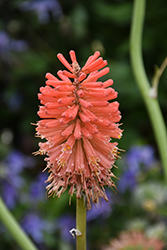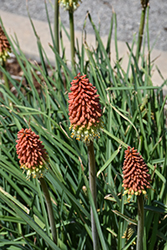It's all about ...
plants

Plant Height: 3 feet
Flower Height: 4 feet
Spacing: 22 inches
Sunlight:
![]()
![]()
Hardiness Zone: 7a
Other Names: Red-hot Poker, Regal Torchlily
Description:
Hummingbirds love the beautiful yellow and coral red colored bottlebrush type flowers that rise from grassy, blue-green foliage in midsummer; an unusual yet brilliant border or container plant that will form colonies; makes a great cut flower
Ornamental Features
Torchlily features bold spikes of coral-pink tubular flowers with yellow overtones and green throats at the ends of the stems from mid to late summer. The flowers are excellent for cutting. Its attractive grassy leaves remain bluish-green in colour with hints of silvery blue throughout the year.
Landscape Attributes
Torchlily is an open herbaceous evergreen perennial with tall flower stalks held atop a low mound of foliage. Its relatively fine texture sets it apart from other garden plants with less refined foliage.
This is a relatively low maintenance plant, and should be cut back in late fall in preparation for winter. It is a good choice for attracting hummingbirds to your yard, but is not particularly attractive to deer who tend to leave it alone in favor of tastier treats. It has no significant negative characteristics.
Torchlily is recommended for the following landscape applications;
- Accent
- Mass Planting
- Rock/Alpine Gardens
- General Garden Use
- Container Planting
Planting & Growing
Torchlily will grow to be about 3 feet tall at maturity extending to 4 feet tall with the flowers, with a spread of 24 inches. When grown in masses or used as a bedding plant, individual plants should be spaced approximately 22 inches apart. It grows at a medium rate, and under ideal conditions can be expected to live for approximately 10 years. As an evegreen perennial, this plant will typically keep its form and foliage year-round.
This plant does best in full sun to partial shade. It prefers dry to average moisture levels with very well-drained soil, and will often die in standing water. It is considered to be drought-tolerant, and thus makes an ideal choice for a low-water garden or xeriscape application. This plant should not require much in the way of fertilizing once established, although it may appreciate a shot of general-purpose fertilizer from time to time early in the growing season. It is not particular as to soil pH, but grows best in sandy soils. It is somewhat tolerant of urban pollution. This species is not originally from North America. It can be propagated by division.
Torchlily is a fine choice for the garden, but it is also a good selection for planting in outdoor pots and containers. With its upright habit of growth, it is best suited for use as a 'thriller' in the 'spiller-thriller-filler' container combination; plant it near the center of the pot, surrounded by smaller plants and those that spill over the edges. It is even sizeable enough that it can be grown alone in a suitable container. Note that when growing plants in outdoor containers and baskets, they may require more frequent waterings than they would in the yard or garden. Be aware that in our climate, most plants cannot be expected to survive the winter if left in containers outdoors, and this plant is no exception. Contact our experts for more information on how to protect it over the winter months.
This plant is not reliably hardy in our region, and certain restrictions may apply; contact the store for more information.

